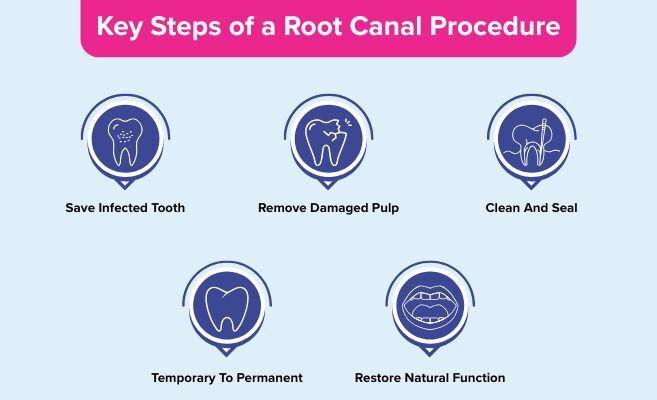Step-by-Step Guide to the Root Canal Procedure

Root canal sounds scary, right? But trust me, it’s one of the best ways to save a tooth that’s going bad or causing pain. Once you know what’s gonna happen step by step then it won’t feel so scary even you will feel more confident and ready to handle it!
If you’re looking for root canal treatment in Chennai then this guide explains everything in plain and in easy woay. It will answers even common questions and shares tips to make it smoother. So, keep reading to know how a root canal can help fix your tooth and get your smile back!
What is a Root Canal Procedure?
A root canal procedure also known as endodontic therapy and it is basically a treatment that helps to repair and save a tooth that is badly damaged or infected. Inside your tooth there is a soft part called pulp which contains nerves and blood vessels. If this pulp gets infected due to deep cavities, cracks or an injury then it can also lead to severe pain and swelling. A root canal removes the infection and protects the tooth from further damage to helping you keep your natural smile.
Key points:
- The goal is to remove the infected pulp.
- Clean and disinfect the inside of the tooth.
- Seal it to prevent further infection.
- Restore functionality with a crown or filling.
By undergoing a root canal patients can avoid tooth extraction and maintain a natural smile while eliminating pain and infection.
Signs You Might Need a Root Canal
Recognizing early warning signs is essential for timely treatment. Consider scheduling a consultation at a dental clinic in Chennai if you experience:
- Persistent toothache, especially when chewing or applying pressure.
- Prolonged sensitivity to hot or cold food and beverages.
- Swelling or tenderness in nearby gums.
- Darkening of the tooth.
- Pimple-like bumps on the gums near the affected tooth.

Early intervention increases the success rate and reduces the risk of complications.
Step-by-Step Process of a Root Canal Procedure
A root canal treatment typically requires 1–3 visits, depending on the complexity of the case. Here’s a detailed breakdown of each step:
1. Initial Consultation and Diagnosis
The first step involves a thorough dental examination. Dentists often use:
- Dental X-rays are used to detect the extent of infection or damage.
- Clinical assessment to evaluate symptoms and tooth structure.
This step ensures accurate diagnosis and helps plan the procedure effectively.
2. Local Anesthetic Application
The dentist will always administer a local anesthetic to numb the area around the affected tooth and many patients report they experience little to no discomfort in this part of the procedure.
3. Tooth Isolation
During the procedure, the tooth to be fixed will be isolated with a rubber dam. The rubber dam facilitates isolating the tooth so that it remains dry, free of saliva and is also isolated from any potential contamination from the oral cavity.
4. Access Opening
An opening is made directly into the tooth (small) to go into the pulp chamber and the root canals of the tooth. The dentist now has access to the tooth structure to start the process to remove the infected pulp and successfully clean the canals.
5. Cleaning and Shaping the Canals
The dentist uses specialized instruments to:
- Remove the infected pulp completely.
- Shape the canals to allow proper filling.
- Irrigate the canals to eliminate bacteria and debris.
This step is critical to prevent reinfection and ensure long-term success.
6. Filling the Canals
Once the canals are cleaned and shaped, they are filled with a biocompatible material called gutta-percha. This seals the tooth and prevents bacteria from entering.
- The filling may be done in a single visit or over multiple visits if there is a significant infection.
7. Temporary Restoration
After filling, a temporary filling may be placed to protect the tooth until a permanent restoration is ready.
8. Permanent Restoration
A permanent crown or filling restores the tooth’s structure and function. This step is crucial for maintaining strength and preventing future fractures.
- Crowns are often recommended for molars or heavily damaged teeth.
Challenges and Considerations
While root canal procedures are highly successful, there are a few challenges to keep in mind:
- Complex root structures: Some teeth have multiple or curved canals, which may require advanced techniques.
- Reinfection risk: Poor oral hygiene or untreated dental issues can lead to reinfection.
- Temporary discomfort: Mild pain or sensitivity may persist for a few days post-procedure.
Following post-treatment care instructions significantly improves outcomes.
Aftercare Tips for Root Canal Patients
Proper care ensures long-lasting results:
- Avoid chewing hard foods on the treated tooth until the permanent restoration is placed.
- Maintain oral hygiene with gentle brushing and flossing.
- Take prescribed medications if needed to manage pain or inflammation.
- Attend follow-up appointments to monitor healing
Benefits of a Root Canal Procedure
A root canal does more than relieve pain. Some advantages include:
- Preserves your natural tooth.
- Restores normal chewing and biting functionality.
- Eliminates infection and prevents its spread.
- Enhances oral health and prevents future complications.
By saving your natural tooth, you avoid the need for bridges, implants, or dentures.
Common Myths About Root Canal Treatment
Misconceptions often make patients hesitant. Let’s debunk some:
- Myth 1: Root canals are extremely painful.
Modern anesthesia and techniques make the procedure virtually pain-free.
- Myth 2: Extraction is better than a root canal.
Preserving your natural tooth is preferable as it maintains jaw structure and bite alignment.
- Myth 3: Root canals require multiple, painful visits.
Most procedures are completed in 1–2 visits, depending on the complexity.
Understanding the facts helps reduce anxiety and promotes timely treatment.
How Radiant Dental Care Ensures a Smooth Root Canal Experience
At Radiant Dental Care, the root canal procedure is designed with precision, comfort, and patient education in mind:
- Advanced technology for accurate diagnosis and treatment.
- Gentle and pain-free procedures using modern anesthesia.
- Experienced dental professionals skilled in complex cases.
- Personalized aftercare guidance for optimal healing.
Patients seeking root canal treatment in Chennai can trust Radiant Dental Care for high-quality care and a stress-free experience.
Why a Root Canal Procedure is Essential for Your Dental Health
When your tooth is badly hurt or infected then a root canal is the quickest and sure-shot way to fix it. It helps stop the pain and gets your mouth back to normal. But it’s totally okay to feel nervous about knowing what’s going to happen step by step makes you feel more confident and prepared.
At Radiant Dental Care we use the latest treatments and take care of you like family, making sure your teeth are in good hands when you go for a root canal in Chennai.
So don’t wait! Talk to an expert today and find out how you can get a pain-free, happy smile!
Frequently Asked Questions:
How painful is a root canal procedure?
Ans. Most patients report little to no pain during a root canal procedure because modern anesthesia ensures a comfortable experience. Some mild discomfort or sensitivity may occur after the treatment, but it usually subsides within a few days.
Can a root canal procedure save a badly decayed tooth?
Ans. Yes, a root canal can save even severely decayed or infected teeth. The procedure involves removing the infected pulp, cleaning and disinfecting the canal, and sealing the tooth to prevent further damage, allowing the natural tooth to be preserved.
How long does a treated tooth last after a root canal?
Ans. With proper oral hygiene and a permanent restoration such as a crown, a tooth treated with a root canal can last a lifetime. Regular dental check-ups help ensure the longevity of the treated tooth.
Are there alternatives to a root canal?
Ans. The primary alternative to a root canal is tooth extraction. However, extracting a tooth may require additional procedures like dental implants or bridges to restore chewing function and aesthetics making root canals the preferred option for preserving natural teeth.

 +91 9513446186
+91 9513446186
